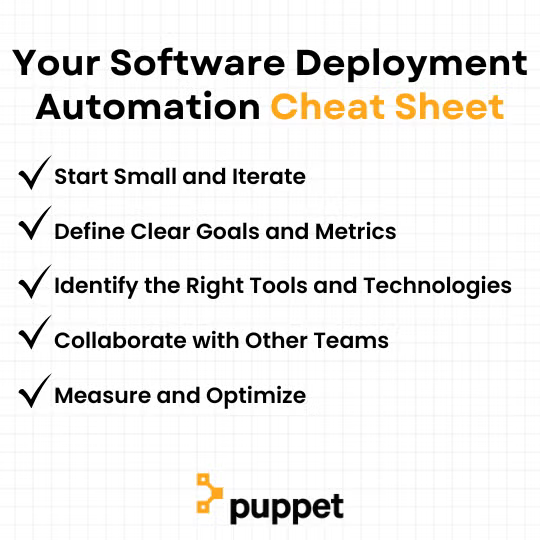Blog
November 20, 2024
What is Software Deployment Automation & Which Tool is Right for You?
DevOps,
Infrastructure Automation
Software deployment automation can simplify and speed up your delivery cycle. It can reduce risk, allow teams to easily test after changes are made, and help provide consistency for the overall development pipeline.
If it sounds complicated, we’re here to break it down each step into a cheat sheet that provides tips and best practices for the software deployment automation process.
Table of Contents
- What is Software Deployment Automation?
- The Benefits of Software Deployment Automation
- Your Software Deployment Automation Cheat Sheet
- Software Deployment Automation Tools & Examples
- Software Deployment Automation Tips to Keep in Mind
What is Software Deployment Automation?
Software deployment automation streamlines software delivery by automating tasks across development, testing, and production environments, significantly reducing manual effort and accelerating time-to-market.
Software deployment is tricky, time-consuming, and complex. Things don’t always go as planned, and sometimes things break along the way. Even if your deployment pipeline is strong and your end goal is solid, it doesn’t always mean that you’ll get where you need to go.
Automation offers an alternative. With a single click, software can move from a testing environment to production. This also means that after that click, DevOps can ensure that everything is running smoothly, and fast.
There are many places where you can incorporate deployment automation within existing DevOps processes. Here are some examples:
- Infrastructure as Code (IaC): When code needs to be deployed across a larger infrastructure, automation can help.
- Continuous Integration/Continuous Delivery (CI/CD) Pipelines: Commonly called CI/CD pipelines, these workflows help developers build, test, and deploy software with continuous integration.
- Service Orchestration: Important updates, patches, and other services can be automatically applied to different environments using automation.
The Benefits of Software Deployment Automation
Software deployment automation revolutionizes software delivery, accelerates releases, enhances reliability, and boosts efficiency to drive success.
Less Manual Intervention
Let’s say you need to deploy a software update across different infrastructure environments across an organization. With a manual process, the developer managing the deployment will need to be on call for each step of testing and production. Automation eliminates the need for a single person, or a team, to be on call while software is deployed.
Reduced Time to Deployment
Automation can shorten the length of time needed for deployment — allowing organizations to get their products to market faster. This can help gain a competitive advantage by being able to deliver new features and updates more quickly than competitors.
Fewer Errors, Greater Consistency
With automation, developers can eliminate the possibility of human error that often results from manual deployment process. Automation ensures that the same steps are executed every time, in the same way, without the risk of missing a step or making a mistake.
Automation ensures that the environment in which the software is deployed remains consistent across all deployments. This consistency reduces the chances of configuration errors, version mismatches, and other issues that can arise when deploying to different environments.
Your Software Deployment Automation Cheat Sheet
Let’s break down a few of the most important things you should consider when automating deployment — and in the order that they should appear:

1: Start Small and Iterate
Deployment automation can be a complex and time-consuming process, so it’s important to start small and iterate as you go. Begin by using a deployment automation tool to automate deployment of single, non-critical application or process and then gradually expand to other applications and environments.
As you automate, be open to feedback and make adjustments based on what you learn. (More on that in Step 4.)
2: Define Clear Goals and Metrics
Before you start automating, you should define clear goals and metrics for success. For example, you might want to reduce deployment time, improve software quality, or increase frequency of deployments.
Establishing a watermark of success is a good way to measure the success of your automation efforts, adjust as needed, and help other teams adhere to the process.
3: Identify the Right Tools and Technologies
There are many types of deployment automation tools, but not all of them will be right for your software development processes. The strengths of some (like speed or resource efficiency) might be better suited for organizations of a different size than yours, while the strengths of others (like security, reliability, and scalability) might be better for reaching your specific goals.
It's really important to settle on Step 2 before moving to this stage: After all, you can only pick the right deployment automation tool for the job once you've decided what the job is. Choose the toolchains and solutions that are best suited for your organization’s deployment automation needs.
4: Collaborate with Other Teams
Deployment automation can impact different teams within an organization, including developers, testers, platform engineering teams, security, and IT operations. It’s critical to collaborate with these teams to ensure that everyone is aligned on goals and provides the necessary resources and support to make it a success.
5: Measure and Optimize
Once your automation process is in place, you must continue to measure its effectiveness and optimize as needed. Continuously iterating on your automation process will help you achieve greater success over time.
Software Deployment Automation Tools & Examples
Deployment automation tools are tools that automate deployment of software and apps to development, testing, staging, and production environments. Deployment automation tools can include configuration management, version control, IaC, CI/CD, and more.
Choosing the right deployment automation tools is essential to a successful, efficient, foolproof, repeatable deployment. You can use these types of tools together or in isolation, depending on what your development workflows need.
Type of Software Deployment Automation Tool | What It Does |
Configuration Management Tools | Ensure consistent, repeatable deployments by provisioning, configuring, and managing servers. |
Version Control Systems | Manage deployment scripts and configurations to track and roll back changes. |
Infrastructure as Code (IaC) Tools | Defines infrastructure and application configurations as written code, taking the manual work out of configuring for deployments. |
Continuous Integration/Continuous Delivery Tools | Automatically build and test code when changes are committed to repo. |
Container Orchestration Platforms | Take the manual work out of deploying, scaling, and managing containerized applications in multi-cloud deployments and hybrid cloud environments. |
Software Deployment Automation Tips to Keep in Mind
To make sure your deployment automation is a success, keep these tips in mind:
Start Small
Don’t try to automate it all at once. Start with something non-critical and gradually expand your deployment automation as you gain more experience and confidence.
For example, rather than tackling everything from dev to production, try deploying a single web server:
- Choose the web server you want (like Nginx or Apache).
- Set up your version control repo.
- Provision the infrastructure for that web server using a tool like Terraform.
- Create simple automation scripts (or use a configuration management tool) to install and configure that server.
- Write a simple script to automate testing steps, including install verification, configs, and functionality.
Test, Test, and Test
Some More Automation can reduce the risk of errors, but it’s important to test your automated deployment process before using it in production.
Test the process in a staging environment to ensure that everything works as expected before deploying to production.
Use a Configuration Management Tool
Using configuration management tools like Puppet or Ansible can automate the setup and configuration of your deployment environments.
Some configuration management tools can also enable policy as code (PaC), which is an infrastructure management approach that ensures consistency across your environments to reduce the risk of configuration errors.
Don’t Forget Security
When automating deployment, it’s important to consider security throughout the process. Security automation tools can help by ensuring system hardening measures are enforced across your infrastructure.
Deployment automation is an ongoing process — it’s important to continue learning and improving. Keep up to date with the latest tools and techniques and seek out feedback from other team members to identify areas for improvement.
If you’re manually tackling compliance tasks and wondering how to automate security configurations, don’t miss our webinar, “The Compliance Easy Button:”
Try Out Puppet’s Software Deployment Automation
Interested in seeing deployment automation in action, without a big commitment?
Puppet's agent-based automation and configuration management capabilities allow you to automate software deployment processes across different OSes as well as hosting environments (on-prem, in the cloud, or hybrid).
Try Puppet Enterprise for free today to see better deployment automation in action. With no time limit, you can automate and manage 10 nodes completely free — more than enough to implement automated workflows, testing, and reporting you need to prove out the value of deployment automation.
Start your Puppet Enterprise free trial by clicking the link below.
